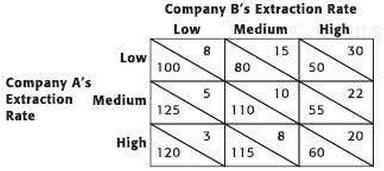Two companies each own property (and mineral rights) in an oil field. Each firm therefore has the
Question:
Two companies each own property (and mineral rights) in an oil field. Each firm therefore has the legal right to drill for oil on its land and take out as much oil as it can. The problem, of course, is that one company’s actions affect how much oil the other can produce. The following matrix represents how each of these companies views the situation. The terms outside the matrix represent oil output by each firm (low, medium or high), while the numbers in each cell show the present value of all oil to be extracted by each company, given the two extraction policies. The first number represents the value to Company A, and the second number represents the value to Company B. As an example, if Company A pumps at a “low” rate and Company B pumps at a “low” rate, then the value to Company A of all the oil it expects to take over the life of the field is $ 100 while the value to Company B of its oil is $ 8.

a. What extraction rates maximize the total value of the oil field?
b. Do the extraction rates maximizing the value of the field represent a stable situation? Explain.
c. Is there a dominant strategy (extraction rate) for either or both players? Explain.
d. Is there a Nash equilibrium set of extraction rates? If so, does it maximize the total value of the oil field?
e. Is there a mutually beneficial exchange inherent in this matrix—one that could solve the problem these two companies face? If Company A were to purchase Company B’s oil rights, how much would it have to pay? Is this a feasible transaction?
Step by Step Answer:

Microeconomics Theory and Applications
ISBN: 978-1118758878
12th edition
Authors: Edgar K. Browning, Mark A. Zupan





